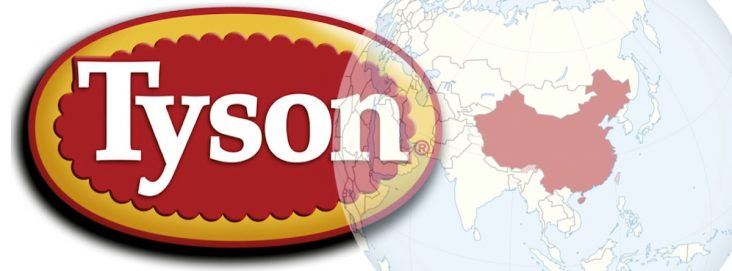Tyson Foods changes directions in China, trying to reverse losses and boost demand
by November 23, 2015 6:26 pm 723 views

China has largely been a black hole for Tyson Foods in terms of earnings but the Springdale-based meat giant said Monday (Nov. 23) it is shifting from food service to a more customer-centric focus in the country of more than 1 billion consumers.
At one time Tyson Foods had a much larger international footprint with operations in Mexico and an expansion into Brazil in 2008 through the acquisition of Macedo, Avita and Frangobrás chicken companies. Also in 2008, Tyson acquired a 51% ownership of Godrej Foods, one of the leading poultry processing businesses in India. For several years Tyson has expanded operations in China with a fully integrated model where they control the bird growing process as well as the plant processing operations.
Tyson recently closed the sale of its Mexican and Brazilian businesses to Pilgrim’s Pride for $575 million and now says it will hold on to India and continue investing in China to the tune of $16 million as it shifts toward consumer marketing. Tyson now plans to tap into the burgeoning online grocery business with more ready-to-eat products, shifting away from the raw commodity chicken that has previously been sold at retail.
Tyson Foods CEO Donnie Smith was asked by analysts Monday (Nov. 23) during the company’s earnings call about its plans in China. Smith said China has yet to become profitable as the company incurred a $169 million impairment charge in the recent quarter. He said for “Tyson 2.0” the international operations will continue to include China and India. Smith said India is a small business, but is stable. China has been far more challenging.
Smith said record low wholesale chicken prices have continued for months amid food safety concerns throughout China. Tyson’s largest customers in China include Kentucky Fried Chicken and Wal-Mart.
Smith said Tyson’s previous strategy was on serving its corporate customers, but that is changing to a consumer-centric focus to allow for higher gross margins. He said Tyson now has a marketing team in China designed to bring more retail products to Chinese consumers looking for convenience. In the past year, Tyson Foods has developed 22 new frozen chicken products designed for higher-income consumers who also shop online.
Smith said most of the business in China will be anchored in chicken, but there could be expansion into other proteins. He told analysts that Tyson’s efforts in China is a “good story to share.”
It’s been a waiting game of sorts as Tyson Foods began several years ago investing into integrating the chicken-growing side of the business in an effort to guarantee improved food safety standards that have been weakened by repeated Avian Influenza outbreaks.
Tyson built its own facilities and began processing controlled birds just about the time consumer demand for chicken plummeted. Tyson has remained committed to its plan and is ready to ramp up production as soon as demand rebounds. Now it looks as if Tyson is investing in efforts to boost demand by bringing new products to consumers in multiple sales formats.
